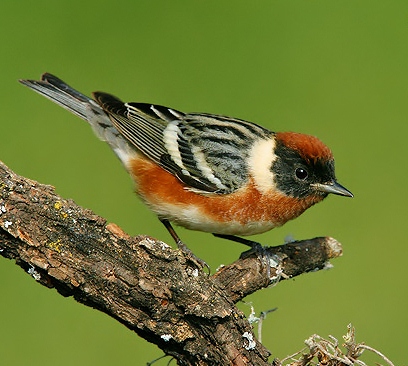 |
| Photo by Brian Small (Lananhbirds Club) |
Common name:
bay-breasted warbler (en); mariquita-de-peito-castanho (pt); paruline à poitrine baie (fr); chipe castaño (es); braunbrust-waldsänger (de)
Taxonomy:
Order Passeriformes
Family Parulidae
Range:
This species is found breeding in central and eastern Canada, and across the border into the north-western United States. They migrate along the eastern half of North America and Central America to winter in northern Colombia, Venezuela and the Caribbean.
Size:
These are 14 cm long and have a wingspan of 20-22 cm. They weigh 10-17 g.
Habitat:
Bay-breasted warbler nest in open boreal forests, especially spruce and fir either in pure stands or mixed with clumps of aspens, birch and balsam poplar. During winter they are found in tropical moist forests and second growths.
Diet:
They mainly feed on caterpillars, particularly spruce budworms Choristoneura sp., but also take adult insects, spiders and fruits during winter.
Breeding:
Bay-breasted warblers nest in a small cup made with dried grass, stalks, mosses, roots, twigs, lichens, insect and spider webs. The nest is lined with strips, hair of rabbit and plant down and placed in a spruce, birch, hemlock tree or even in scrubs, 4-12 m above the ground. The female lays 4-7 white or creamy eggs with dark spots, which she incubates alone for 12 days. The chicks are fed by both parents and fledge 10-11 days after hatching, but continue to be fed by the adults for several days.
Conservation:
IUCN status – LC (Least Concern)
This species has a large breeding range and a global population estimated at 3-3,5 million individuals. the population has undergone a small decline over the last 4 decades, possibly as result of spraying for spruce budworms. Loss of wintering habitat may also be a problem.







